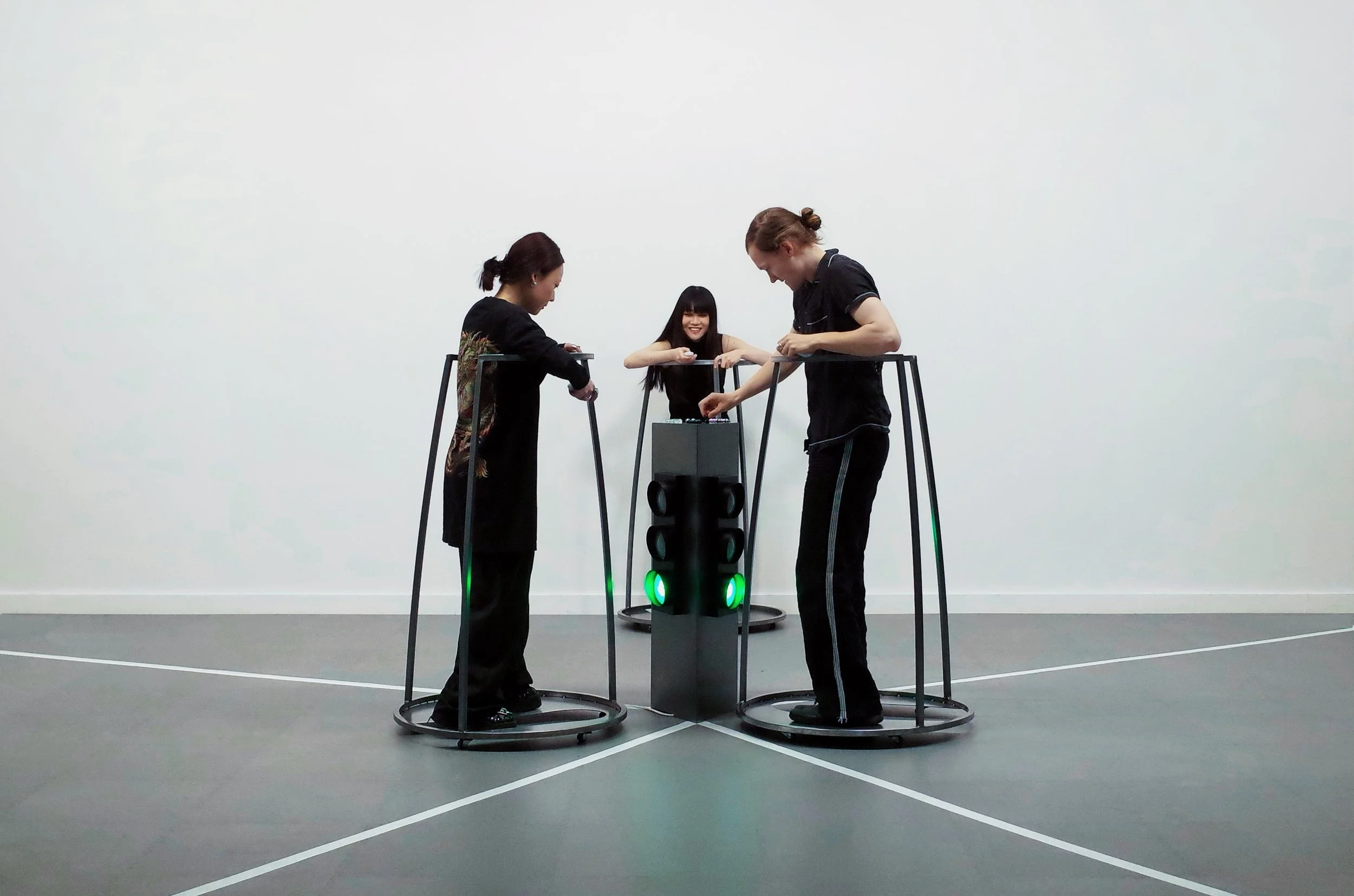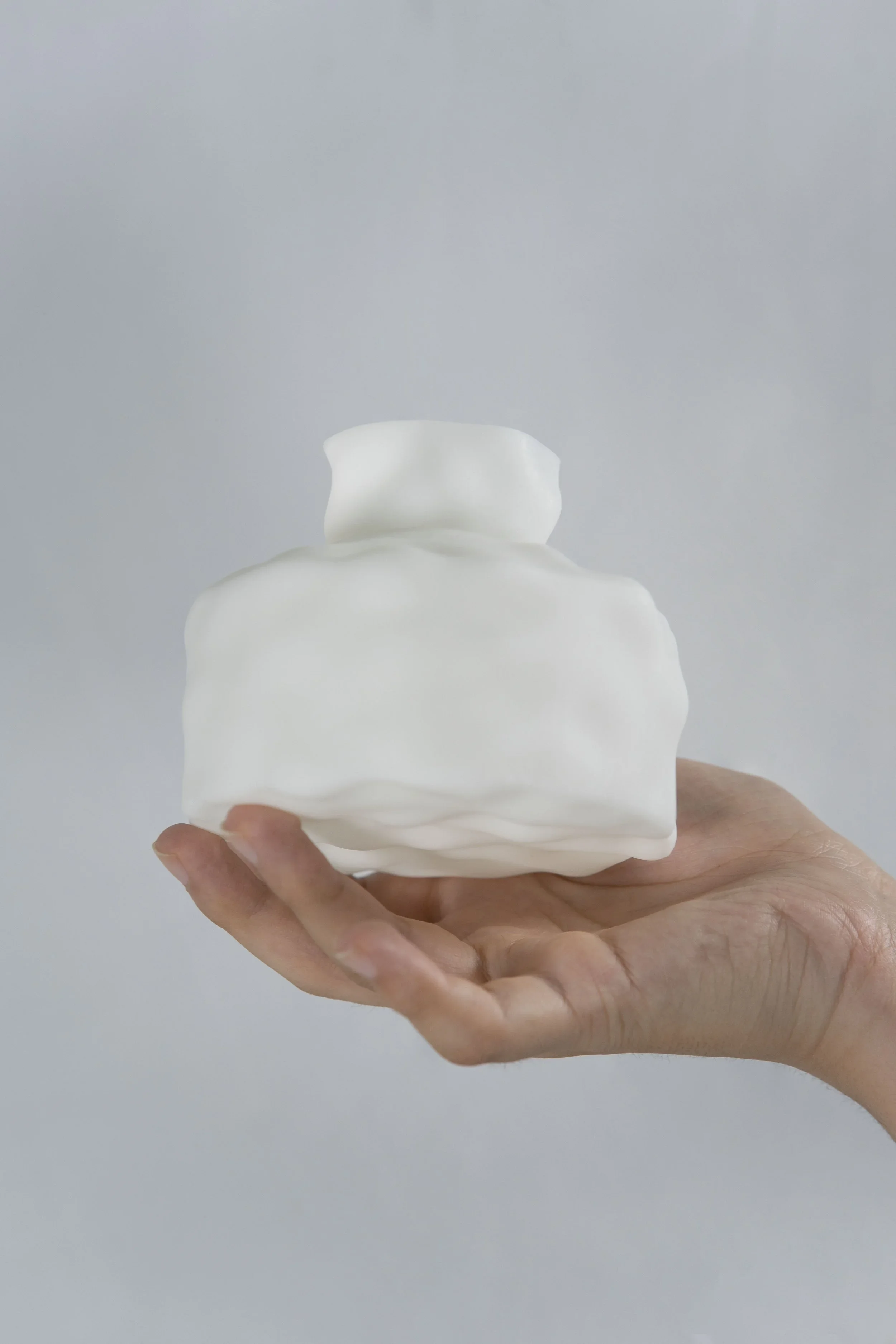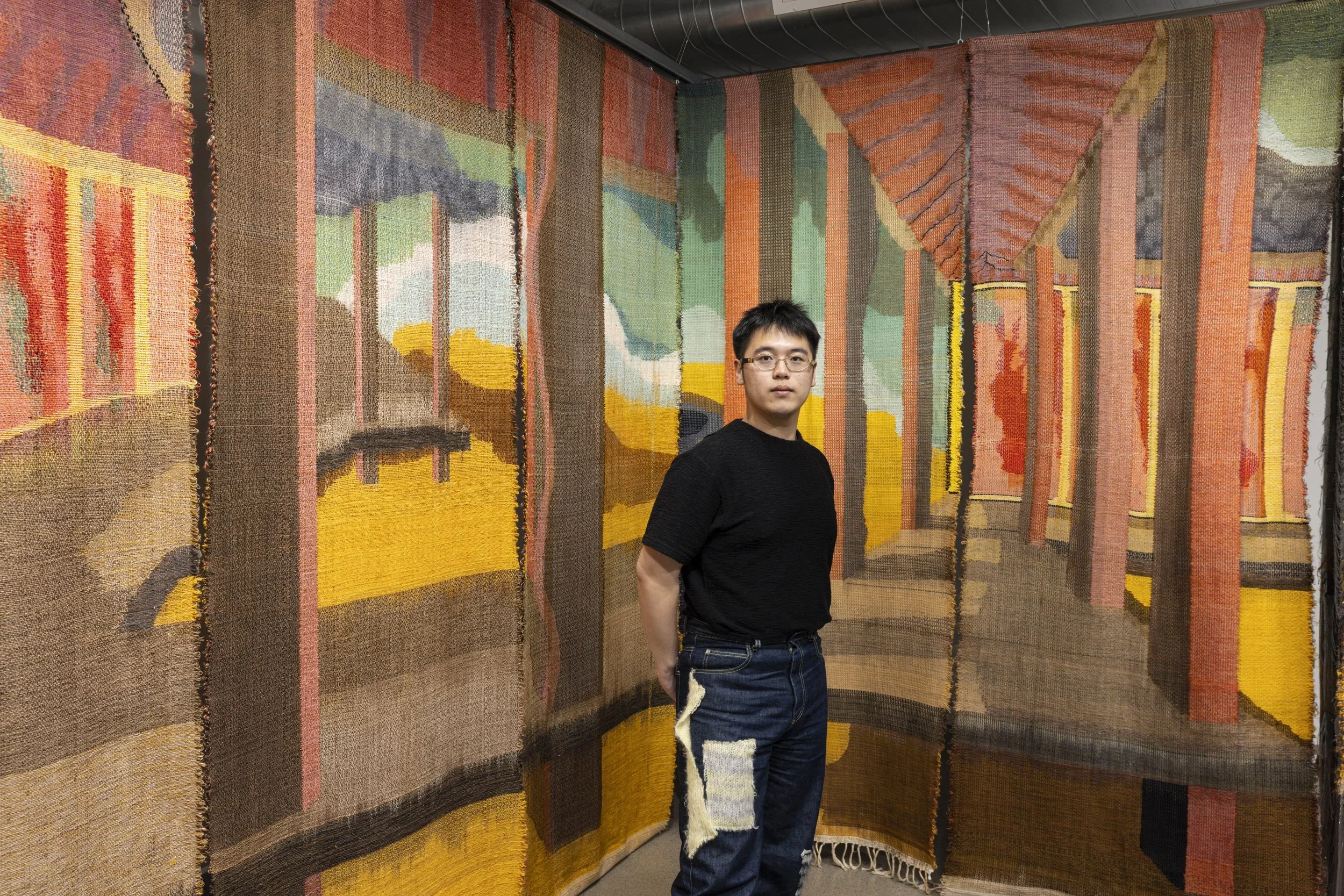10 Questions with Wanrong Zhu
Wanrong Zhu is a multimedia visual artist from China and based in London. Her work focuses on the relationship between AI and society, exploring virtual reality, dynamic imaging, installations, performances, and artificial intelligence.
In 2021, she collaborated with "Bazaar Art" and Beijing United Family Hospital on the outdoor landmark art therapy installation "Gedulah". In 2023, she produced the closing piece for Wuhan Fashion Week using XR technology for a virtual reality metaverse fashion show titled "Shi Kuang". In June 2023, her digital art, "The Fence of the Screen," utilizing thermochromic technology, was featured in the opening exhibition at Chongqing YOUNG SPACE Museum. She held an exhibition at RCA titled "Requiem for the White Lily" in December 2023. Her work, "Symphony of Shadows", was shortlisted for the SOLO AI '24 AWARD in 2024. Her multimedia immersive installation "Spirit Never Dies" was displayed at the Fitzwilliam Museum in Cambridge on April 30, 2024.
Wanrong's artistic career is marked by continuous exploration and challenging boundaries, inviting audiences into a world where technology and art intertwine, offering novel expressions of human emotions and collective memory.
Wanrong Zhu - Portrait | Photo by Nini
Dream Series: An Exploration of Subconscious Realities | Project Description
The "Dream Series" is a profound exploration into the subconscious mind, materializing the ephemeral nature of dreams into tangible artistic expressions. This series comprises three distinct works, each delving into different facets of the human psyche—death, inner shadows, and anxiety—drawn from the artist's meticulous collection of 100 recurring dream archives. Through this series, Zhu aims to bridge the gap between the elusive world of dreams and concrete reality, inviting viewers to traverse the boundaries of their own subconscious experiences.
No. 86, Installation, 2024 © Wanrong Zhu
INTERVIEW
Please introduce yourself to our readers. Who are you and what inspired you to pursue a career in art?
My name is Zhu Wanrong, and I am a multimedia visual artist from Yunnan, China, passionate about researching new technologies and exploring the realms of virtual and reality. I always enjoy exploring "imagination." I've always been the unruly "bad student." My memories seem to start from kindergarten. At that time, I particularly enjoyed organizing my classmates to act out scenes from TV dramas and perform plots beyond the original endings, allowing my classmates to improvise freely. In elementary school, I often daydreamed while staring at my textbooks, reimagining the content of the texts and even the illustrations. I was always deeply immersed in it. This kind of thinking, which unfolds based on the feelings of the moment and extends to more possibilities, always intrigued me. In those moments, I seemed to confuse time and space, with the contents of the books and my real self appearing to be in the same space. This fascinated and excited me. Additionally, I am exceptionally fascinated by dreams. I can almost remember all my dreams. Sometimes, I am aware that I am dreaming. The different experiences brought by dreaming at various times of the day, the moments in real life that feel identical to past dream scenarios, and repeatedly dreaming the same dream all captivate me. When I was very young, I told my parents that I wanted to invent a "dream recorder" to capture all my dreams. I believe these experiences sparked my interests. Long-term focus and continued exploration of these matters have led me to develop different perspectives and thoughts about the world.
Can you tell us about your journey from China to London and how it has influenced your artistic perspective? How has your experience at the Royal College of Art shaped your approach to photography?
From an artistic perspective, these experiences didn't have a particularly unique impact. However, the greatest influence on me was that they made me more confident and determined to boldly express my inner thoughts. My time at RCA made me realize that photography is not just about taking pictures; it can encompass many forms of expression, such as performance, writing, sculpture, sound, and more. This broadened my understanding of photography. It is not just about images or videos. For me, a piece of writing, a performance, or a piece of music can evoke imagination in the viewer, even if the imagery only exists in their minds. What I mean is that photography should not be confined to being two-dimensional or three-dimensional; it should be a multidimensional experience. Therefore, when I came to London, you could see that the presentation of my work became more diverse: installations, sculptures, projections, performances, and sound.
Let's now focus on your work. What drew you to focus on the relationship between technology and humanity in your art?
This is a complex and multi-faceted theme. What fascinates me the most is that technology not only provides new creative tools and means of expression for art but also induces continuous reflection during its use. For instance, the manifestation of humanity within technology and the impact of technology on the value of art are aspects that intrigue me deeply.
White Lily's Requiem, Installation, Mixed Media, VR 6’ 35’’, 2 Videos 2’ 46’’, Film 1’ 23’’, 2024 @ Wanrong Zhu
Artist - Wanrong Zhu
Sound design - Ziying Wang
White Lily's Requiem serves as the opening chapter of the "Dream Series," rooted in the recurring dream of searching for a deceased puppy. This work embodies the themes of loss and death, transforming deeply buried emotions into a visual and sensory experience. Through AI-generated videos, projections, and installation art, the piece constructs a world that is both illusory and real. This installation immerses the audience in a space filled with emotional fluctuations and philosophical reflections, showcasing the potential of AI technology in modern art creation.
In this piece, the white lily symbolizes purity and the ephemeral nature of life, while the requiem serves as a metaphor for mourning and remembrance. The AI technology used in this work transforms the intangible memories of a lost companion into a tangible reality, allowing the audience to experience the emotional depth and philosophical inquiries related to memory and loss. This work questions how we maintain our connection to the past and find new meaning and hope in the face of loss.
White Lily's Requiem, 2024 @ Wanrong Zhu
Could you walk us through your creative process? How do you integrate AI and other new technologies into your work?
For example, my dream series began with my personal experiences and a curiosity about the commonalities in people's dreams. I frequently have dreams that feature recurring scenes and themes, such as being chased, encountering terrifying creatures, and visiting fantastical amusement parks. I discovered that many of us share similar dream experiences. This curiosity about the commonalities in our subconscious prompted me to delve into Freud's dream analysis and Jung's theory of the collective unconscious and, with the help of artificial intelligence, explore and present our shared psychological and emotional experiences.
I collected dreams from 100 different people who had the same experience—repeatedly dreaming the same dream. I trained a ChatGPT model, specializing in psychoanalysis and dream research, to conduct an in-depth analysis of these dream archives, reflecting key fragments of the shadow archetype in the collective unconscious. Additionally, I trained an AI visual model in the style of documentary and film to generate visual images of these "shadow" dream fragments from different individuals. These fragments were then recombined and edited to be displayed in an immersive multimedia auditory space, creating a vivid collective shadow dreamscape. When viewers are in this space, they experience and recall the "shadow" memories and feelings from their dreams. "I've dreamed this before" ... "I've also dreamed this" ... "I feel oppressed" ... "I feel anxious" ... "I am scared" ...
Your upcoming trilogy—White Lily's Requiem, Symphony of Shadows, and No.86—explores dreams, memory, and AI. What inspired these themes?
"Death," "inner shadows," and "anxiety" are the profound feelings in dreams that prompted me to create this series of works. The "Dream Series" consists of three chapters, all based on the 100 recurring dream archives I collected. The first work, White Lily's Requiem, involves repeatedly dreaming of searching for a deceased puppy, exploring themes of loss and death in dreams. The second work, Symphony of Shadows, extracts fragments related to the shadow archetype from 100 dreams, delving into the collective unconscious "shadows" shared by humanity.
The third work, No. 86, is a typical dream about anxiety. Notably, this work does not use any AI. I used a 360-degree camera to film performances and combined it with VR to provide an immersive viewing experience. By integrating virtual reality technology and various media, an immersive dream space was created. In this piece, all media are suspended in the air, forming a heterotopian visual effect. Viewers enter this space by wearing VR glasses, experiencing strange dancers, rapidly changing scenes, and incomprehensible dialogues, which evoke intense tension and unease. After removing the VR glasses, viewers feel as if they have awakened from a dream and are eager to share their experiences with others. Through reflections on anxiety, this work explores the relationship between dreams and reality, questioning the legitimacy of social rules and authority. The symbols and narratives in the dreams appear unusual because they are not bound by rules, yet these anomalies precisely break through the strict rules of reality.
Symphony of Shadows, Installation, Mixed Media, VR 6’ 35’’, 2 Videos 2’ 46’’, Film 1’ 23’’, 2024 © Wanrong Zhu
Artist - Wanrong Zhu
Sound design - Nalehs
Archive layout - Zommer
"Symphony of Shadows" delves into Carl Jung's theory of the collective unconscious by utilizing AI to analyze and retrieve the "shadows" from 100 individuals' recurring dreams. This work explores the repressed and denied aspects of the human psyche, presenting a collective dream that reveals the shared unconscious experiences among humanity.
Through AI-driven analysis and the recombination of dream fragments, this piece constructs a vivid collective shadow dream space. Viewers are invited to immerse themselves in this multimedia auditory environment, where they can feel and recall the "shadow" memories and emotions experienced in dreams. The project underscores the interconnectedness of human experiences, emphasizing that despite apparent isolation, we are deeply connected through our collective unconscious.
The interactive element of this work, where viewers can input their own shadow archetype dreams, further enriches the collective dream narrative. This continuous addition of viewer-generated content highlights the evolving relationship between individual subconsciousness and the collective, showcasing the potential of AI and art collaboration in exploring human emotions and psychology.
How do you envision the interplay of dreams, memory, and AI influencing viewers' perceptions of your work? And what do you hope audiences take away from experiencing the trilogy you are about to unveil?
First and foremost, I believe that artificial intelligence is not merely a tool for me. The visual effects it creates are very similar to those in dreams, resembling the collective unconscious of humans. AI has a similar impact. I hope viewers reflect on how the rules considered "normal" in real life are formed and how these rules influence our cognition and behavior. Its role in contemporary visual culture is not only reflected in technological innovation and multimediaexpression but also in its profound social critique and emotional resonance, prompting viewers to reconsider their cognitive and behavioral patterns.
In your opinion, what role does memory play in preserving our past and defining our future, especially in the context of your work?
The preservation of memory is the invisible evidence of our past existence. It constructs our identity, as past experiences, emotions, and events shape our character and values, making us unique individuals. Memory influences our future. In this series of works, memory plays a crucial role in preserving the past and defining the future. Through artistic expression and the use of AI technology, personal and collective memories are transformed into visual and sensory experiences, exploring how memory affects our emotions, identity, and social rules.
AI is the biggest innovation we have seen in recent years, and some people compare it to the Industrial Revolution or the introduction of the Internet. What is your stance on this matter? And what are the most significant differences and synergies you've noticed between traditional and AI-enhanced art forms?
I believe that artificial intelligence is indeed one of the most revolutionary innovations of recent years, comparable to the Industrial Revolution and the advent of the internet. AI has not only transformed how we process data and solve problems but has also had a profound impact across various fields.
In the realm of art, the application of AI demonstrates the deep integration of technology and human creativity. While AI has changed the methods of art creation, it has not replaced the unique value of traditional art. Instead, the synergy between AI and traditional art forms is ushering in a new era of art, pushing it towards broader and richer horizons. In this process, artists, technologists, and society as a whole need to collaborate to ensure the harmonious coexistence of technological advancement and humanistic values.
No. 86, Installation, Mixed Media, VR 6’ 35’’, 2 Videos 2’ 46’’, Film 1’ 23’’, 2024 © Wanrong Zhu | Photo by Yu Ying Chan
No.86 utilizes virtual reality to create an immersive space built upon collective unconsciousness, using dreams as a medium to draw the audience into a fictional world. This work aims to evoke shared experiences and emotions deep within the audience, thereby challenging the social rules and authority in the real world.
All media are suspended in the air like black mirrors, symbolizing a heterotopia—a distortion and reflection of reality. At the same time, it serves as a metaphor for a dystopian world. The images within these mirrors create a fictional space filled with oppression and unease, reflecting another side of reality.
When the audience puts on VR glasses and enters this immersive space, they encounter strange dancers emerging from the darkness, rapidly approaching and then suddenly retreating, accompanied by incomprehensible dialogues and indescribable fears. The audience feels intense tension and anxiety, as if they are in an inescapable trial.
The moment the audience removes the VR glasses, it is as if they have awakened from a dream, eager to share their experience with others. This urgency mirrors the feelings people have upon waking from a dream—perplexed and astonished by the symbols and scenes they just witnessed. Through this, the work provokes the audience to ponder why dreams appear "strange": why do the symbols and scenarios in dreams seem so bewildering when we are awake?
Dreams are free from rules, with the subconscious flowing freely; in real life, our cognition is shaped and regulated by rules, with clear distinctions between good and evil, right and wrong, and black and white. It is precisely these rules that make everything in life seem "normal," while the "strangeness" in dreams breaks these conventions.
"Dreams have no rules - the subconscious is unrestrained."
The world within the mirror symbolizes a dystopian fictional space, representing both a dialogue between the self and the subconscious and a metaphor for the oppression and unease in the real world. In society, there are rules and distinctions between good and bad, right and wrong, black and white. We use these rules to understand, categorize, and shape our cognition, making everything unsurprising and "normal." Conversely, in dreams, "strange actions" and "strange events" break our rules and common sense.
No. 86, Installation, 2024 © Wanrong Zhu | Photo by Ziying Wang
How do you hope your work will contribute to the broader conversation about technology and humanity in art?
By combining artificial intelligence technology with artistic creation, my works not only showcase the potential and possibilities of technology but also delve deeply into the relationship between technology and humanity. This exploration contributes to a broader discussion on technology and humanity in art: "White Lily's Requiem" utilizes AI technology to concretize personal emotions and memories, creating a space filled with emotional fluctuations and philosophical reflections. In this way, the work demonstrates that technology is not just a cold tool but can also be a medium for profound emotional expression.
In "Symphony of Shadows," by training AI to become an expert model, collaborating and co-creating with AI, and generating videos with AI, the work illustrates how AI can understand and express complex human emotions, challenging the traditional boundaries between technology and humanity.
Looking ahead, what is your ultimate goal as an artist, and how do you hope to achieve it?
Looking ahead, as an artist, my ultimate goal is to pioneer the integration of contemporary art and artificial intelligence technology, expanding the boundaries of visual arts and exploring the relationship between humans and technology. I aim to create innovative visual expressions that delve into human emotions and the psyche, exploring the meaning of human existence between the virtual and the real. To achieve this, I will continue researching and experimenting with synthetic media and AI. By fostering human-machine collaboration, I hope to inspire discussions about the role of AI in society and culture, ultimately contributing to a deeper understanding of our existence and the potential of technology in art. Additionally, I aim to continuously explore the evolving relationship between humans and technology through my artistic practice.
Artist’s Talk
Al-Tiba9 Interviews is a promotional platform for artists to articulate their vision and engage them with our diverse readership through a published art dialogue. The artists are interviewed by Mohamed Benhadj, the founder & curator of Al-Tiba9, to highlight their artistic careers and introduce them to the international contemporary art scene across our vast network of museums, galleries, art professionals, art dealers, collectors, and art lovers across the globe.





















